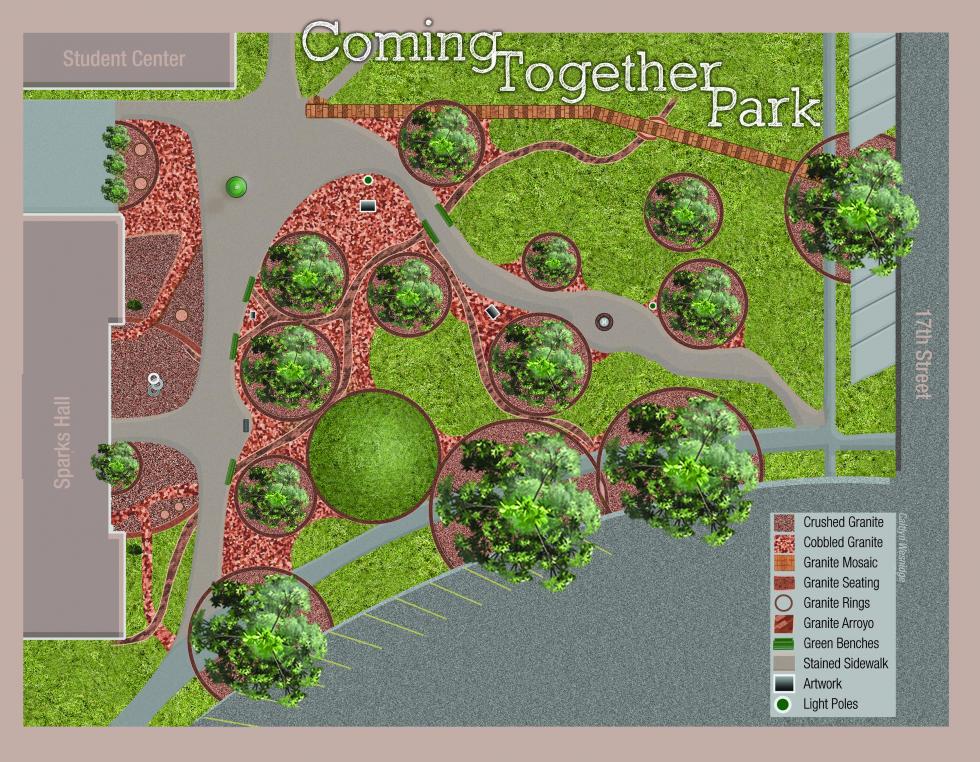Coming Together Park Essay

There are few experiences that underscore the relentless nature of time than a visit to the old hometown. Though most of the infrastructure, the roads, the landmarks, may be the same as we remember, new businesses, new schools, even new faces remind us that time stands still for no one. This outward transformation mirrors our own development as individuals, our ideas and understandings in a state of constant flux even as our bodies slowly decay over time. We create to stave off this sense of mortality. We write books. We bring children into the world. We develop and contribute to bodies of scholarship. These are the legacies that survive us.
At the University of Science and Arts of Oklahoma, we are the inheritors of a shared legacy that stretches over a century. The legacy of the determined community that came together in order to found the college. The legacy of the exceptional women who came together to give the Oklahoma College for Women its reputation for excellence. The legacy of the visionaries, administrators, faculty and students alike, who came together at the Oklahoma College of Liberal Arts to forge the DNA of our current mission. Our own four-decade legacy as USAO, coming together to overcome challenges and exceed expectations as we worked to fulfill the potential of our legislative mandate.
In our dreams and memories, the campus, where we spent perhaps the most formative years of our lives, will always be the same. In reality, it is as susceptible to the forces that transform us all, both creative and destructive. There is a small bench, built by the class of 1928 that sits beneath a tree between Austin and what is now called Troutt Hall. It represents a remarkable outpouring of creativity and genuine love for the campus. It’s also slowly crumbling and there’s nothing that can be done about it. No one has the heart to remove it and so it remains in the shade of the tree, just feet away from where picnic table and park bench seating is now available in the sunlit plaza nearby.
In the past few years, we’ve taken some bold steps to preserve the past. The restoration of the President’s home and the Stevens Alumni House. The recreation of the classic Greek theater. The Alumni Chapel. We’ve also contributed to the future legacy of the school with the addition of the Owens Flag Plaza, the Circle, two pieces of public art and, of course, the recently dedicated of statue of Te Ata that now graces the Oval.
Now, we are embarking on perhaps the most ambitious campus overhaul in history of the institution. In conjunction with world renowned master granite sculptor Jesús Moroles, the entire area north of the Oval, bordered by Sparks Hall and the Student Center, is to be transformed into an area known as Coming Together Park.
The Park will feature walkways and plazas made from a combination of granite, concrete, brick and grass. Much of the granite will come from the foundation of the home Ingrid Shafer lived in during the OCLA years. A memorial plaza will be dedicated to her memory. At strategic points in the park, other stone features will be added, again encouraging students to inhabit the space rather than merely pass through it. Moroles is already hard at work designing unique stone tables and benches to make this a place that will lure students out of their dorms to come together for conversation and discussion.
The result will be a space that is, at once, new to the campus but still rooted in the values that every incarnation of the institution has shared. While many schools are reaching out to prospective students with new student centers that are indistinguishable from the shopping malls of old, we are doubling down on distinctiveness, inviting students to get out, to get active, to gather, to come together.
We need input, passion and leadership from all of our alumni to help build the Coming Together Park into the outward manifestation of the university’s most deeply held values. Just like every part of the campus you inhabited, no matter the era, the park will inspire students of today and tomorrow to shape their own legacies according to the values that we, the college community, hold dear and in common between us as our bond.
To aspire to any less would be a disservice to all those who came together before us to forge the legacies of which we are the beneficiaries.
